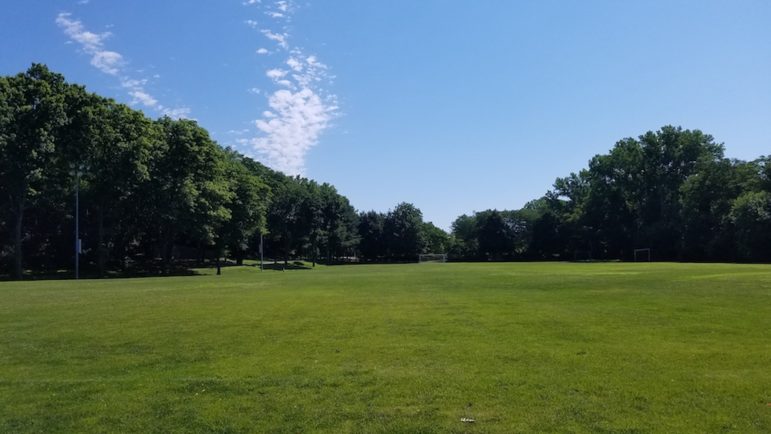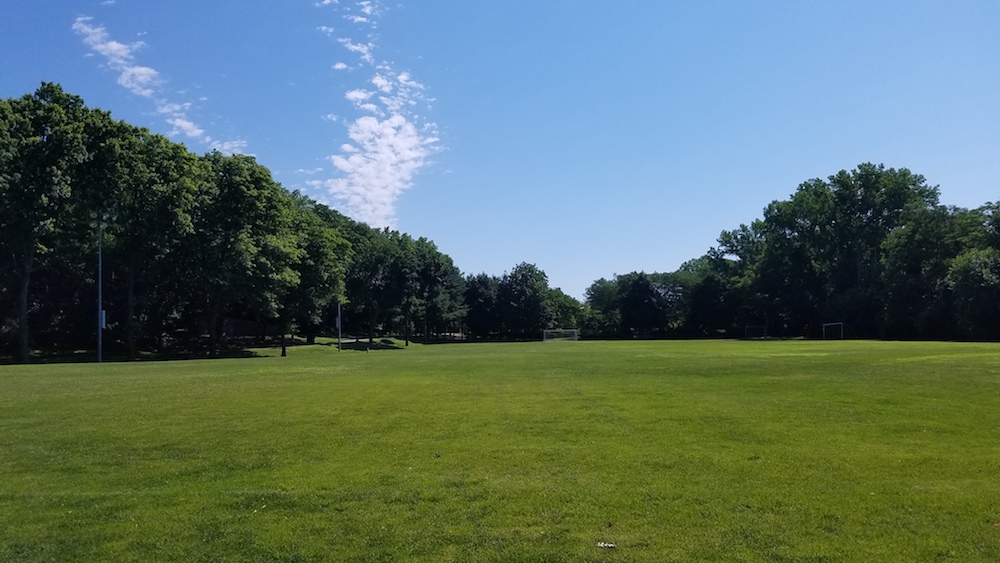
The Town Council heard about the proposed project to add lights to one athletic field at Filippello Park and to replace them on another field, and they debated whether they should have the capability to shine stronger for higher level of competition.
Currently, there are lights at the softball field, near the Grove Street side of the East End park, but the soccer field near Arlington Street have no illumination. The plan presented by contractors CDM Smith called for putting new lights up on both fields, with the ones on the Grove Street softball field stronger than those for the Arlington Street Field.
At a future meeting, the Town Council will be asked to consider a $900,000 loan order to cover most of the $1.3 million projected cost of the lighting project, which also includes replacing the scoreboard and backstop at the Grove Street Field. See the documents related to the lights project by clicking here.
Level of Lighting
The Illumination Engineering Society has four classes of lights for athletic fields, based on the type of sports, level of competition and number of spectators. The range is from Class 1 (professional, college or semi-professional competitions with capacity for more than 5,000 spectators) to Class 4 (amateur leagues, high school and youth sports with limited or no spectators).
Glenn Howard, from CDM Smith, said that the Grove Street Field was planned as a Class 3 (sports clubs, amateur leagues and high school sports with up to 2,000 spectators), and the Arlington Street Field would be Class 4.
The softball field on the Grove Street side will have 50-foot-candle strength lighting on the infield, and 30-foot-candle lights on the outfield, as well as lights that shine up so outfielders can see fly balls.
The lights on Arlington Street Field were recommended for 20-foot-candle lights by CDM Smith. He said the difference between the two fields is that the softball games draw small crowds, while only a handful of people come to watch the games at the Arlington Street Field.
The new lights will be LED, and have focused fixtures so most the light will be contained to the field, Howard said, and little light spillage will impact neighboring houses.
Howard said the initial designs, on which the budget is based, called for having 30-foot-candle lights at Arlington Street as well (and that was the plan discussed at the last community meeting in July). If the Town decided to reduce the strength of those lights, it could save up to $15,000, but the amount is not guaranteed. If Town officials decided they wanted to increase the illumination after they are installed, it would cost about $80,000 because new fixtures would need to be installed.
Resident Elodia Thomas questioned whether Class 3 lighting was needed at either of the fields.
“(Class 3) is for up to 2,000 spectators. That’s not what these feels are about,” Thomas said. “Tier 4 is appropriate for recreation leagues and youth sports.”
She worried that the fields are being lighted for uses with more spectators, such as renting to adult leagues, which she did not think was appropriate when the project is being paid for by the taxpayers.
Governor’s Councilor Marilyn Petitto Devaney told the Council that there used to be lights “like those at Fenway Park” on the fields when Filippello Park was first built, but they were removed when neighbors complained.
Which Option?
There is an option to put up lights with stronger capabilities, Howard said, but can be reduced to lower light levels on a computer or smartphone. Also, the lights can be limited by the voltage of electricity going to the lights, but in this option, the only way they can be adjusted is to have the manufacturer come out and adjust the voltage manually.
Town Councilor Anthony Donato said that there may be need for using the Arlington Street Field for high school sports during the construction of the new Watertown High School.
“I do not want more light than necessary but if we are not sure and are able to dim them we are better off setting them lower and have the ability to increase the light,” Donato said.
Town Council President Mark Sideris said he spoke to the Watertown School’s Athletic Director, Ryan Murphy, who said that he and Superintendent Dede Galdston would like to have some flexibility because of all the unknowns around the direction of the high school building project. The new WHS has not yet been designed, and a site has not yet been chosen.
Councilor Angeline Kounelis said that the area near the Arlington Street Field does not have enough parking for significant numbers of spectators, and the area is already impacted by recreation league players.
“It is very difficult to accommodate adult leagues where players come in individual vehicles,” Kounelis said. “It inconveniences the neighborhood until 10:30 or 11 p.m.”
She added that she does not think it is worth the financial risk of paying $80,000 if Town officials determine more light is needed at the Arlington Street Field after the project is completed.
Controls of the Lights
Council Vice President Vincent Piccirilli said he would like to see the ability to change the strength of the light, but he does not want it to be as easy as using an app to change it.
“I would only support it if we have hard wiring. Programming the lights (on an app) can be changed by anyone,” Piccirilli said. “I have been frustrated by the Recreation Department over lighting at Victory Field and having the lights on all the time, even when it is raining or snowing.”
Councilor Tony Palomba said he prefers to have the flexibility of having lights being dimmed by an app, and does not want to make the decision based on the personnel of any Town department.
The project has received an International Dark Sky Association Award of Excellence for the project. Piccirilli asked if the Town would get the project certified after construction is complete. Assistant Town Manager Steve Magoon said they would, but there is a cost associated with it. Piccirilli noted that certification requires a policy for using the lights.
Sideris said a policy could be made that sets the levels of the lights, which could only be changed with the authorization of the Town Manager.
The Council will decide on whether to fund the project at a later date at a meeting with a public hearing, and the Town administration will put together a policy for the use of the lights.
